The 100th anniversary of the First World War is now finished but the records will continue to be preserved at the Archives and accessible to current and future generations who want to know more about the time period. In addition, this blog will remain on our website as an additional resource.
August 2017 Posts:
- 28 August: Waiting for conscription: “…there will be lots of time yet for soldiering.”
- 21 August: Disposing of Secret Documents: The S.S. Baysoto and Captain Kirby
- 14 August: Closer to the action: Lt.-Col. R. M. Dennistoun, Deputy Judge Advocate General in France
- 8 August: A different perspective – Lt.-Col. R. M. Dennistoun, Deputy Judge Advocate General, C. E. F. HQ, London
28 August 2017
Waiting for conscription: “…there will be lots of time yet for soldiering.”
Although many men were quick to enlist in 1914, this was not the universal response to the outbreak of the First World War. In April 1915, Gordon McKittrick left his home in Thornbury, Ontario not to go overseas, but to work as a bank teller in the Cardinal, Ontario branch of the Bank of Toronto. A young man of 18, Gordon met new people, explored his new surroundings and enjoyed cycling and camping trips.
Later in 1915, Gordon moved west to work in the Benito, Manitoba branch of the bank. He wrote letters home to his parents and brother describing his work, his new friends, and his involvement in sports, the church and the community. He sometimes commented on the First World War and his support for the war effort.
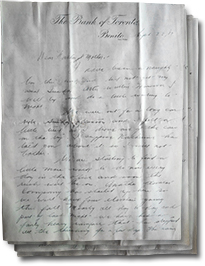
enlarge (4 images)
In 1916 he wrote to his parents:
“I sometimes wish that I had left the Bank business before now and got into something that was a little more interesting to work at all my life, but I guess I will have to keep shoving the pen and be thankful that I don't have to go to war."
On learning that several boyhood friends had enlisted in 1917, Gordon wrote:
“I guess if I had have been home I would be going too. It would be pretty hard to see the other lads all going and me staying at home. However I guess there will be lots of time yet for soldiering."
In the summer of 1917, McKittrick married Kate Whately in Thornbury, Ontario, and she returned with him to Benito. Both Gordon and Kate wrote letters to his parents and brother describing their new life together and expressing their concern that conscription would interrupt it. When the Military Service Act was passed on 29 August 1917, Gordon, like many Canadians, wondered whether it would be enacted.
In a September 25, 1917 letter to his parents Gordon wrote:
“The war question is looking rather black again and it looks as though conscription was coming right along. We had a circular from H. Q. today instructing us to be examined at the medical boards as soon as possible. They make out however that they are arranging with the government to keep all their senior men and managers, so I guess I will be about as safe in the Bank as anywhere else, so I guess there’s nothing to do but sit still and wait for things to take their own course.”
McKittrick was eventually drafted, but was exempted after an appeal. However, this exemption was later overruled and in the spring of 1918, Gordon and Kate returned to Thornbury and he joined the 1st Central Ontario Regiment.
Search Tip: Search “Gordon McKittrick” in Keystone for more information about these records.
Feedback (0)
E-mail us at [email protected] with a comment about this blog post. Your comments may be included on this page.
21 August 2017
Disposing of Secret Documents: The S.S. Baysoto and Captain Kirby
The Bay Steamship Company was a subsidiary company of the Hudson’s Bay Company created in 1916 to establish a fleet of merchant vessels to supply goods during the First World War.
On August 6, 1917 at about 8:30 pm, the Bay Steamship Company ship, S.S. Baysoto was torpedoed by the German submarine UC-42, 37 miles from Aberdeen, Scotland. The crew and captain were rescued from the North Sea. The British Admiralty sent a telegram on August 10th to the Bay Steamship Company informing them of the fate of the Baysoto.

enlarge
Bay Steamship Company, Admiralty telegram to Bay Steamship Company,
10 August 1917, H2-171-1-7 file 3

enlarge
Archives of Manitoba,
Admiralty to Bay Steamship Company,
9 Sept. 1917, H2-171-1-7 file 3
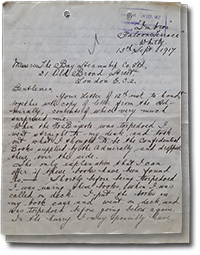
enlarge (2 images)
Archives of Manitoba,
Captain Kirby to Bay Steamship Company,
13 Sept. 1917, RG4/5/278
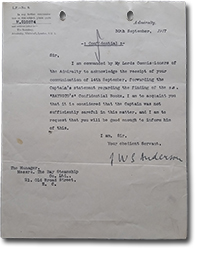
enlarge
A month passed when the Bay Steamship Company received a letter from the Admiralty requesting an explanation from the ship’s captain as to why the Baysoto’s confidential books were not destroyed.
According to the letter, the ship’s books were found floating in the sea on August 14th. Wartime protocols dictated that secret documents should be disposed of by “throwing them overboard in a weighted bag or by ensuring that the box in which they were contained was so weighted that it would sink.”
Four days later, Captain A.S. Kirby responded in a short, two page letter detailing his memory of the attack. In it, Kirby recounted how following being torpedoed, he went to his desk and took out what he thought were the confidential books and dropped them over the side.
In an attempt to explain how the mishap occurred, Kirby wrote:
“Shortly before being torpedoed I was using these books, when I was called on deck. I put the books in my book case and went on deck, and was torpedoed before going below again. In the hurry I may possibly have taken out the wrong books, but previous to getting your communication this morning I never thought of this.”
Kirby’s response was satisfactory and the Admiralty sent back a letter on September 30th instructing the Bay Steamship Company to inform Captain Kirby to be more careful in the matter of destroying secret documents.
The Admiralty sent a similar letter nearly two months later to ensure the message was received.
Search Tip: Descriptions of Bay Steamship Company records are coming soon to Keystone.
Feedback (0)
E-mail us at [email protected] with a comment about this blog post. Your comments may be included on this page.
14 August 2017
Closer to the action: Lt.-Col. R. M. Dennistoun, Deputy Judge Advocate General in France
The 8 August 2017 blog featured R. M. Dennistoun and his diary entries written from the safety of London. In September 1917 Dennistoun found himself much closer to the action when he travelled to France on army business. Dennistoun writes of shelling, bombing and aeroplane fights, some very close to him.
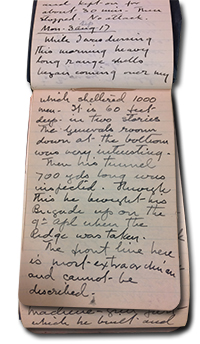
enlarge (3 images)
On 3 September he records:
“while I was dressing this morning heavy long range shells began coming over my billet. One hit a house at the corner near me and demolished it. Casualties unknown.”
While in France, Dennistoun also had the opportunity to see Vimy Ridge and he writes of machine gun shelters that were 60 feet deep and 700 yard tunnels.
“The front line here is most extraordinary and cannot be described.”
Dennistoun also went for several horse rides and had a number of lunches and dinners with dignitaries including members of the French Royal Family. Not the experience of every Manitoban in France at that time!
After the war R. M. Dennistoun was appointed a judge in the Manitoba Court of Appeal. Dennistoun served as a Court of Appeal judge for 28 years until his retirement in 1946. He was well-respected and is remembered today, perhaps mostly in connection with his first Winnipeg home which has recently been demolished after attempts to save it by the heritage community. Dennistoun kept a diary from the start of the First World War until just before his death in 1952.
The R. M. Dennistoun records held at the Archives of Manitoba were recently featured in a CNN/HLN production exploring the genealogy of some of its presenters; CNN analyst Ashleigh Banfield is a great-granddaughter of Robert Maxwell Dennistoun.
Search Tip: Search “Dennistoun” in Keystone to find out more about Robert Maxwell Dennistoun and his First World War diaries.
Feedback (0)
E-mail us at [email protected] with a comment about this blog post. Your comments may be included on this page.
8 August 2017
A different perspective – Lt.-Col. R. M. Dennistoun, Deputy Judge Advocate General, C. E. F. HQ, London
Many of the First World War records at the Archives of Manitoba are letters and diaries written by young Manitoban men who enlisted in the Canadian Expeditionary Force, trained in camps in England and served in the trenches in France and Belgium. They were men who had just finished school or were just starting careers, were single and without dependents. They provide different but similar views of the First World War experience of Canadian soldiers.
The records of Robert Maxwell Dennistoun provide a different perspective of the war. Dennistoun was 49 years old when he enlisted. He was a lawyer who had moved to Winnipeg in 1907 from Ontario. Dennistoun was first given a commission as Captain in the Fort Garry Horse (FGH) and after the FGH was disbanded, he returned to Canada to raise the 53rd Battalion. In 1917 he was appointed Deputy Judge Advocate General, a position at Canadian Expeditionary Force headquarters in London.
Dennistoun had a wife and five children. His two oldest sons also enlisted and served in France. His son Jack was killed in action, shot down behind enemy lines in 1916. His wife Mildred and two young daughters went to England with Dennistoun for the duration of the war.
Dennistoun kept a diary throughout the First World War and his entries in the volumes are mostly summaries of military action, prisoners taken, losses, victories – all seen from the distance and relative safety of London. He also records more personal losses including the death of his son and the deaths and injuries of other relatives and acquaintances.
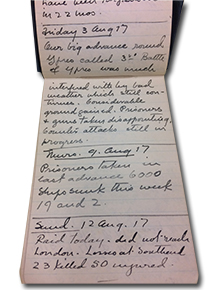
enlarge
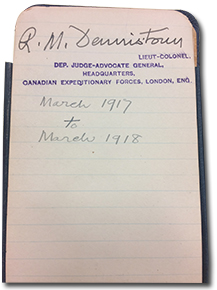
enlarge
Search Tip: Search “Dennistoun” in Keystone to find out more about Robert Maxwell Dennistoun and his First World War diaries.
Feedback (0)
E-mail us at [email protected] with a comment about this blog post. Your comments may be included on this page.



